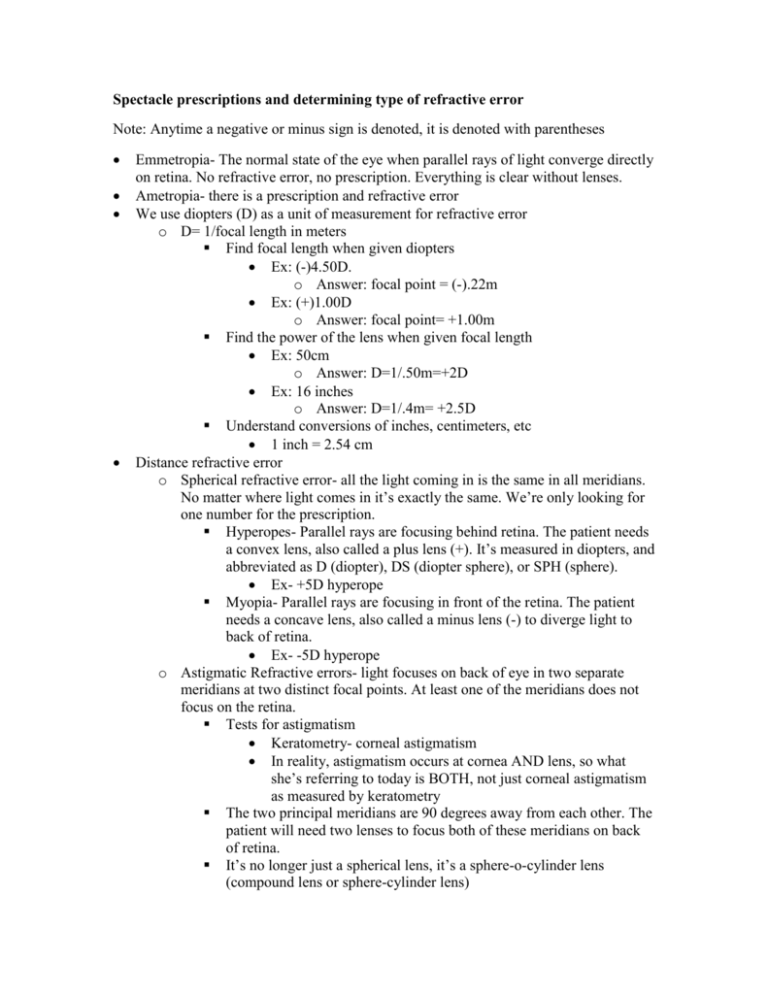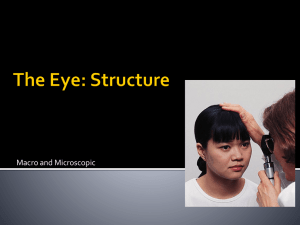Spectacle prescriptions and determining type of refractive error Note
advertisement

Spectacle prescriptions and determining type of refractive error Note: Anytime a negative or minus sign is denoted, it is denoted with parentheses Emmetropia- The normal state of the eye when parallel rays of light converge directly on retina. No refractive error, no prescription. Everything is clear without lenses. Ametropia- there is a prescription and refractive error We use diopters (D) as a unit of measurement for refractive error o D= 1/focal length in meters Find focal length when given diopters Ex: (-)4.50D. o Answer: focal point = (-).22m Ex: (+)1.00D o Answer: focal point= +1.00m Find the power of the lens when given focal length Ex: 50cm o Answer: D=1/.50m=+2D Ex: 16 inches o Answer: D=1/.4m= +2.5D Understand conversions of inches, centimeters, etc 1 inch = 2.54 cm Distance refractive error o Spherical refractive error- all the light coming in is the same in all meridians. No matter where light comes in it’s exactly the same. We’re only looking for one number for the prescription. Hyperopes- Parallel rays are focusing behind retina. The patient needs a convex lens, also called a plus lens (+). It’s measured in diopters, and abbreviated as D (diopter), DS (diopter sphere), or SPH (sphere). Ex- +5D hyperope Myopia- Parallel rays are focusing in front of the retina. The patient needs a concave lens, also called a minus lens (-) to diverge light to back of retina. Ex- -5D hyperope o Astigmatic Refractive errors- light focuses on back of eye in two separate meridians at two distinct focal points. At least one of the meridians does not focus on the retina. Tests for astigmatism Keratometry- corneal astigmatism In reality, astigmatism occurs at cornea AND lens, so what she’s referring to today is BOTH, not just corneal astigmatism as measured by keratometry The two principal meridians are 90 degrees away from each other. The patient will need two lenses to focus both of these meridians on back of retina. It’s no longer just a spherical lens, it’s a sphere-o-cylinder lens (compound lens or sphere-cylinder lens) Now there are 3 different numbers, rather than just 1 of the spherical lens 3 components: 1st- power of the spherical component. It’s either (+) or (-) 2nd- power of the cylindrical portion of eye- always in minus cylinder form (ophthalmologists use plus, we can convert them, but optometrists always use negative) 3rd- axis (orientation) of the cylinder. Denoted as x then the number that always has three digits. To determine power of the two principal meridians: 1st number is the principle meridian 1 2nd number is the sum of the sphere and cylinder components o The second meridian is NOT just the second number in the prescription!! ** Examples: o (+)1.00 -2.00 X 110 Principal meridian 1: (+) 1.00D Principal meridian 2: (+)1.00 -2.00= (-)1.00 D o (-)3.00 – 4.50X010 Principal meridian 1: (-)3.00D Principal meridian 2: (-)3.00D-4.50D= (-)7.50D o (+)4.00- 6.50x175 Principal meridian 1: (+)4.00D Principal meridian 2: (+)4.00D-6.50D= (-)2.5D To determine the axis: You are only given one of the numbers in the prescription, it relates to the cylindrical component. It is not necessarily always the vertical or horizontal axis. You can find the other one by just subtracting or adding 90 degrees to the axis given in the prescription. Examples: o If one meridian is at 60 degrees, where is the other one? Answer: C- 150 degrees o If one meridian is at 90 degrees, where is the other one? Answer: Tricky. It could (by math) either be 0 degrees or 180 degrees, which are mathematically the same. In optometry we always use 180, never zero. o Question asked- “What is the physical difference between spherical and cylindrical. What does that mean?” o Her answer: Refers to difference in curvature of astigmatism of the patient. Spherical is always more plus, cylindrical is always more minus. It helps us understand how light is refracted in the eye. o Measurement of axis: Phoropter- looks like a protractor. Zero is on the patient’s left (doctor’s right), goes in sequential order to 180. This is the location of the axis. We can separate types of astigmatism With rule- 160-20. Anywhere near horizontal line Against rule- closer to vertical number (90) Oblique axis- closer to 45 or 145. Most rare Types of astigmatism: o Note: if the principal meridian is (+) it’s behind the retina, it its (-) it’s in front of the retina. If it’s zero, it’s on the retina and it’s called plano (PL). Simple astigmatismo One meridian is on the retina, the other is either in front of or behind the retina o Simple hyperopic (SHA)- 1 principal meridian on retina, one that’s behind the retina Ex- (+)1.50 -1.50 x 180: Principal meridian 1= (+)1.50 (behind the retina) Principal meridian 2= (+)1.50 – 1.50= 0 (or PL) Ex- (+)4.00 -4.00 x 90: Principal meridian 1= (+)4.00 (behind the retina) Principal meridian 2= (+)4.00 – 4.00= 0 (or PL) o Simple myopic (SMA)- one principal meridian is in front of retina, one is on retina. Ex: Pl- 1.50 x 180 Principal Meridian 1= 0 or plano or PL Principal Meridian 2= 0-1.50= (-)1.50D Compound astigmatismo Both points are in front or both behind retina depending on if it’s hyperopic (behind) or myopic (in front) o Compound hyperopic (CHA)- Both focal points are behind the retina. Both principal meridians are positive. Ex: (+) 1.50 – .50 x 160. Principal meridian 1: (+)1.50D Principal meridian 2: (+)1.50-.50= (+)1.00D o Compound myopic (CMA) Both focal points are in front of the retina. Both principal meridians are negative. Ex:(-)1.50 – 2.00 x 150. Principal meridian 1: (-)1.50D Principal meridian 2: (-)1.50-2.00= ().50D o Mixed astigmatism (MA)- one is in front, one is behind. One is positive, one is negative Ex:(+)2.00 -2.50 x 120. Principal meridian 1: (+)2.00D Principal meridian 2: (+)2.00-2.50= ().50D Ex: (+)2.00-4.00x90 Principal meridian 1: (+)2.00D Principal meridian 2: (+)2.00-4.00= ()2.00D So these patients need two different prescriptions o Presbyopia- Age related condition that occurs around age of 40. The patient has problems accommodating or focusing eyes up close. Need extra plus power to make things clear up close. Need ADD lens A patient with the prescription (+)1.00– 2.00x 180 comes to see you and you determine with refraction and near testing that they have presbyopia. The ADD is a spherical addition power over their distance prescription, so in this case, we add a (+)2.00D ADD. So their new prescription would be (+)3.00 -2.00x180. Principal meridians for their original prescription (+)1.00– 2.00x 180 o Principal meridian 1: (+)1.00 o Principal meridian 2: (+)1.00-2.00= (-)1.00D Principal meridians for their ADD prescription (+)3.00 2.00x180. o Principal meridian 1: (+)3.00D o Principal meridian 2: (+)3.00-2.00= (+)1.00D Presbyopia is due to accommodation- increase in plus power that we naturally do with our lens to make things clear up close (whatever is not at optical infinity or 20ft). We naturally have the ability to accommodate but we lose this ability over time. When the eye is looking at infinity, the ciliary body sphincter muscle contracts and pulls on zonules of zinn. This makes it flatter and it doesn’t have as much (+) power. When we want to accommodate, tension on zonules are released. The lens is no longer pulled flat, so it becomes more fat and more convex. Accommodation adds more plus power. Lose this ability over time, and this causes presbyopia. o Figure out refractive diagnosis (Dx) given prescriptions by calculating the principal meridians -1.00 DS Answer: Simple myope (SM) (+)5.25- 5.25x095 Answer: One principal meridian on retina, and one is plus. It’s a simple hyperopic astigmat (SHA) -2.50-0.50x145 Answer: They are both in front of the retina. It’s a compoint myopic astigmat (CMA) +3.00-3.50x170 Answer: We have a (+) and a (-) it is a mixed astigmat (MA) pl-4.50x035 Answer: One is on the retina, one is (-) so it’s a simple myopic astigmat (SMA) o Figure out which Rx is written incorrectly Rules: always put proper symbol in front (+) or (-). Dr. To usually puts this in brackets so that it’s clear. SPH, D, and DS denote a spherical prescription. Always write sphere and cylindrical components to 2 decimal points. Go in quarter diopter increments, althought sometimes you can do less than that but typically it’s quarter diopter increments. If is is a spherical prescription make sure two write all 3 numbers (spherical component, cylindrical component, axis). The second number is always negative. **She corrected a problem in notes on pg. 25- it says “-3.25-2.25” in the second prescription, change it to “-3.25+2.25” she was trying to demonstrate ophthalmology convention. These numbers are the same and we will learn how to convert them in other courses. Examples: find out what’s wrong with these presciptions -1.000 DCyl o Should be written DS, D, or SPH. We don’t write cylindrical component by itself EVER. -1.50–150x01 o Forgot a decimal, axis should be 3 numbers .75-3.00x030 o Needs a sign on the spherical component, should be a zero before .75. +3.00 o Needs a D or a DS -1.75+.075 x 175 o move decimal place over in second number, second number should be (–) not (+) Vocabulary (latin)- not tested on but may be helpful in our courses or career o Prefix- status, direction, time, when o Root- body party o Suffix- condition, procedure or disease ** The list of vocabulary words, prefixes, suffixes, and roots that she went over in class is on pages 26 and 27. I did not include it here because it was exactly the same as the list in the notes and I didn’t want to take up 2 more pages of space!









